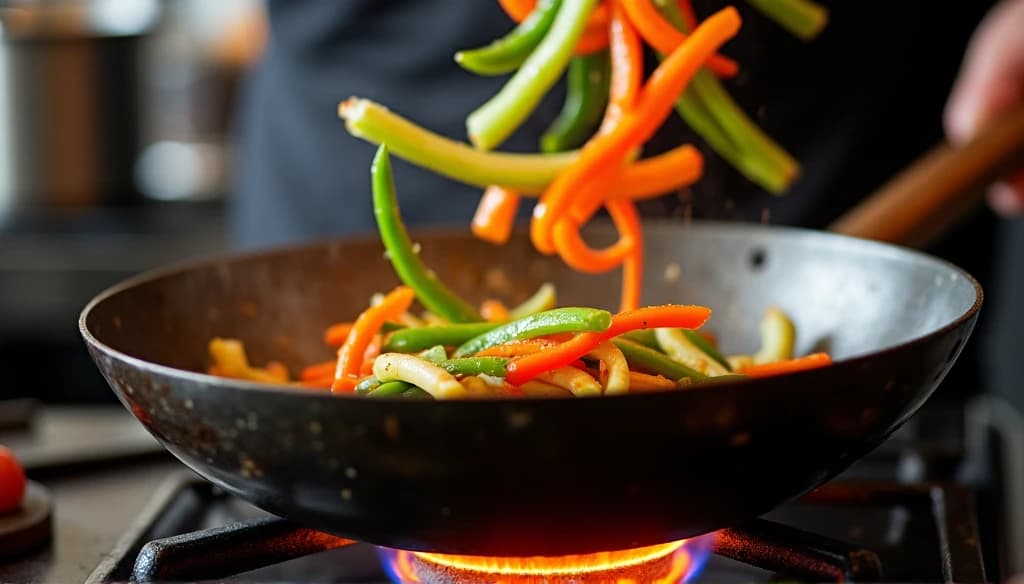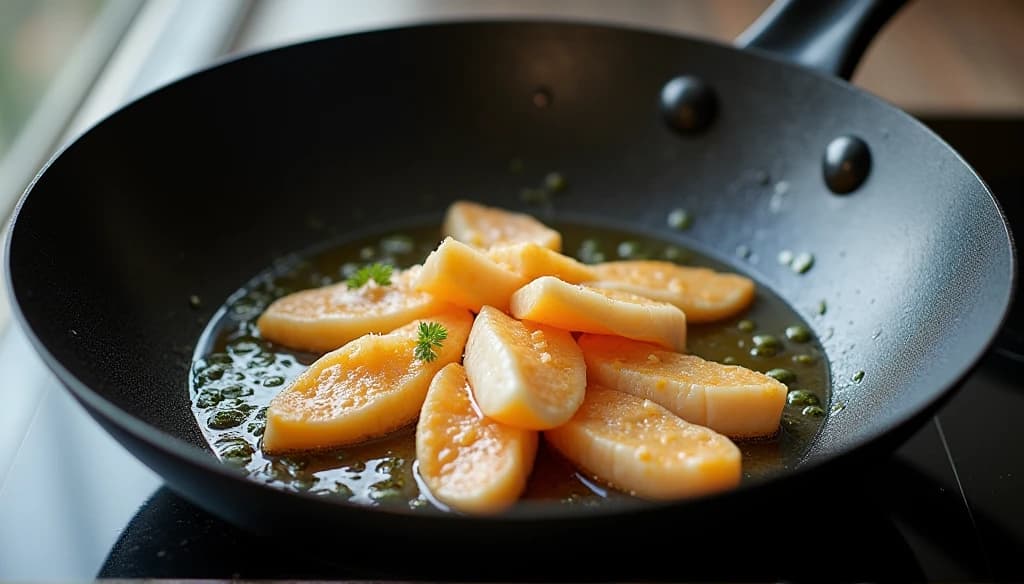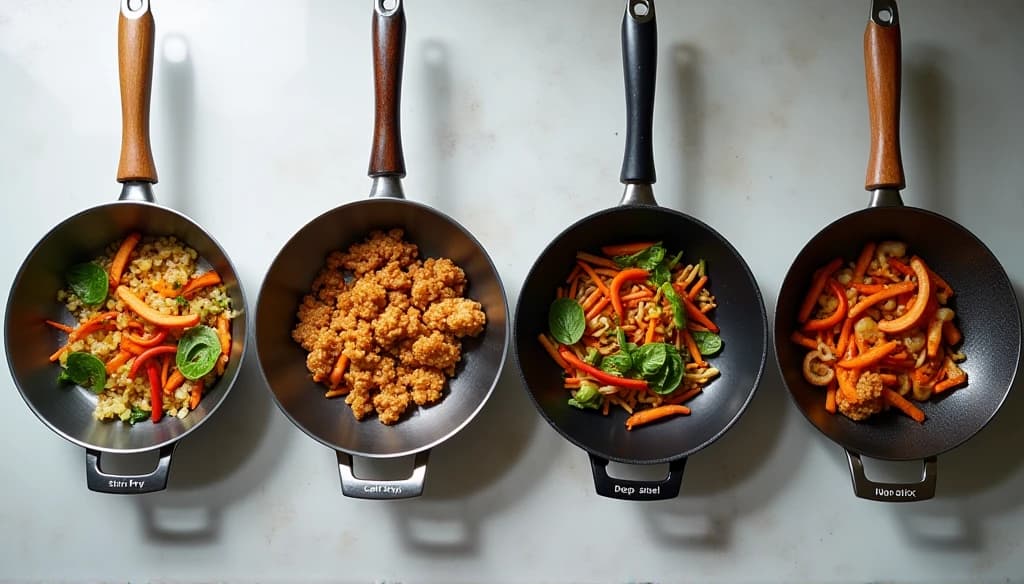Table of Contents
ToggleIntroduction: Is the Wok the Ultimate Kitchen Tool?
Have you ever struggled to get that perfect sear on your stir-fry or wished your veggies had that elusive restaurant-style char? If so, it might not be your recipe that’s lacking—it’s your cookware. Enter the wok, a versatile kitchen tool that has been a staple in Asian cuisine for centuries. But with so many types available, how do you know which wok is your perfect match?
In this comprehensive review, we’ll dive deep into the world of woks, exploring the pros and cons of different materials—from carbon steel to cast iron, non-stick, and stainless steel. We’ll also compare prices and help you find the best wok for your cooking style and budget. So, whether you’re a seasoned chef or a home-cooking enthusiast, this guide will help you make an informed decision.
What Is a Wok?

A wok is a round-bottomed cooking vessel originating from China. Known for its versatility, a wok can be used for stir-frying, sautéing, steaming, deep-frying, and even smoking. It distributes heat quickly and evenly, making it ideal for high-heat cooking. Woks are traditionally made from carbon steel, but today, they are available in a variety of materials, each with its own advantages and drawbacks.
Types of Woks: Which One Is Right for You?
1. Carbon Steel Wok

Carbon steel is by far the most popular material for woks, and for good reason. Its lightweight design and excellent heat conductivity make it the go-to choice for professional chefs. With proper seasoning, carbon steel develops a natural non-stick surface.
Best Use Case
- Stir-frying: Perfect for quick, high-heat cooking.
- Deep-frying: Carbon steel heats up fast and maintains its temperature, making it great for frying.
Pros
- Lightweight and easy to maneuver.
- Heats up quickly and evenly.
- Affordable.
- Develops a natural non-stick surface over time.
Cons
- Requires seasoning and regular maintenance.
- Can rust if not properly cared for.
- May warp under extreme heat.
Price Range
- $20 – $50 for basic models.
- $50 – $100 for high-end, pre-seasoned options.
2. Cast Iron Wok

Cast iron woks are heavier and take longer to heat up, but they retain heat exceptionally well, which is great for slow cooking and deep-frying. Cast iron woks are typically available in either traditional bare cast iron or enameled versions.
Best Use Case
- Steaming and slow cooking: Cast iron excels in heat retention, making it a good choice for dishes that require longer cooking times.
- Deep-frying: The wok holds heat well, ensuring consistent frying temperatures.
Pros
- Excellent heat retention.
- Can be used on a variety of heat sources, including induction.
- Long-lasting with proper care.
Cons
- Very heavy and difficult to maneuver.
- Requires regular seasoning unless enameled.
- Slow to heat up.
Price Range
- $30 – $75 for bare cast iron.
- $75 – $150 for enameled versions.
3. Non-Stick Wok

Non-stick woks are perfect for those who want easy cleanup and are less concerned about traditional cooking techniques. While they don’t offer the same heat distribution as carbon steel or cast iron, they are ideal for low to medium-heat cooking.
Best Use Case
- Low-fat cooking: Great for healthier stir-fries without much oil.
- Delicate foods: Perfect for cooking eggs or fish, where sticking would be an issue.
Pros
- Easy to clean.
- Doesn’t require seasoning.
- Lightweight and easy to handle.
Cons
- Cannot withstand high heat, limiting its versatility.
- Non-stick coating wears out over time.
- Not suitable for traditional stir-frying at high temperatures.
Price Range
- $25 – $60 for entry-level models.
- $60 – $120 for premium brands.
4. Stainless Steel Wok

Stainless steel woks are durable and low-maintenance, but they don’t offer the same heat conductivity as carbon steel or cast iron. However, many high-end stainless steel woks come with an aluminum core to improve heat distribution.
Best Use Case
- Sautéing and searing: Stainless steel works well for browning food evenly.
- Versatile cooking: Suitable for a range of temperatures and cooking methods.
Pros
- Durable and rust-resistant.
- Doesn’t require seasoning or special care.
- Can be used with metal utensils.
Cons
- Poor heat conductivity unless it has an aluminum core.
- Food can stick, making cleanup harder.
- Heavier and more expensive than carbon steel.
Price Range
- $40 – $100 for standard models.
- $100 – $200 for premium cookware with an aluminum core.
Get my Best keto recipes From HERE
Price Comparison Table
| Wok Type | Price Range | Pros | Cons |
|---|---|---|---|
| Carbon Steel | $20 – $100 | Lightweight, fast heating, affordable | Requires seasoning, prone to rust/warping |
| Cast Iron | $30 – $150 | Excellent heat retention, durable | Heavy, slow heating, requires maintenance |
| Non-Stick | $25 – $120 | Easy to clean, no seasoning needed | Not suitable for high heat, coating wears out |
| Stainless Steel | $40 – $200 | Durable, rust-resistant, versatile | Poor heat conductivity without aluminum core |
How to Choose the Right Wok for Your Kitchen

1. Cooking Style
If you’re a fan of high-heat stir-frying, a carbon steel wok is your best bet. For slow-cooking or deep-frying, a cast iron wok may be a better choice. If you prioritize ease of cleaning, a non-stick wok is ideal, though it may not handle high-heat cooking well.
2. Maintenance Commitment
Carbon steel and cast iron woks require seasoning, which can be a deal-breaker for some. If you prefer low-maintenance cookware, opt for stainless steel or non-stick.
3. Heat Source
Consider your heat source. If you have an induction stove, make sure the wok you choose is compatible. Cast iron and many stainless steel woks work well with induction, while traditional carbon steel may require a flat-bottom design for electric ranges.
4. Budget
While carbon steel woks are generally the most affordable, higher-end options like stainless steel or enameled cast iron can be worth the investment if you use your wok frequently.
Conclusion: The Right Wok for Every Kitchen
Whether you’re a stir-fry enthusiast, a deep-frying pro, or just looking for a versatile kitchen tool, the wok is an indispensable addition to any kitchen. From the fast-heating carbon steel to the durable cast iron, and the easy-to-clean non-stick and stainless steel options, there’s a wok for every cooking style.
By understanding the strengths and weaknesses of each type of wok, you can invest in the right one that fits your culinary needs and budget. With proper care, a good wok will last you years and help elevate your cooking to new heights.
Happy cooking!
Frequently Asked Questions (FAQs)
Why is seasoning important for a wok?
Seasoning helps create a natural non-stick surface and prevents rust, especially for carbon steel and cast iron woks.
Can I use a wok on an induction cooktop?
Yes, but ensure that the wok is induction-compatible. Cast iron and flat-bottomed stainless steel woks usually work well on induction cooktops.
How do I maintain a carbon steel wok?
After each use, clean with hot water and a soft sponge. Avoid soap. Dry thoroughly and apply a light coat of oil to prevent rust.
Is a non-stick wok suitable for stir-frying?
Non-stick woks are good for low to medium-heat cooking but are not ideal for traditional high-heat stir-frying.
What’s the difference between a flat-bottom and round-bottom wok?
Flat-bottom woks are better for electric and induction stoves, while round-bottom woks work best on gas stoves and with a wok ring.





